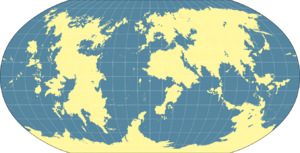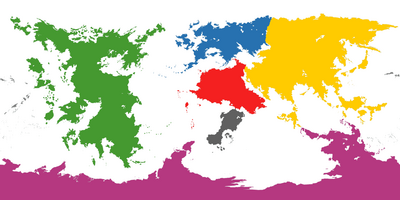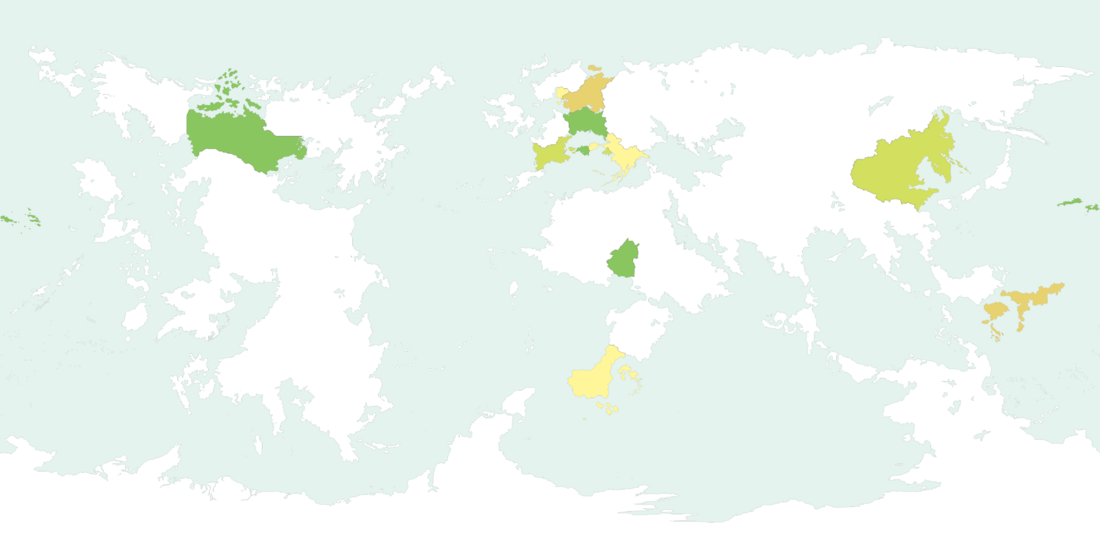Earth (INWU): Difference between revisions
(Created page with "{{Infobox planet | bgcolour = #c0c0ff | name = Earth |adjectives = Earthly, Themian | symbol = File:Sun_symbol.svg|18px|Astronomical sym...") |
No edit summary |
||
| (24 intermediate revisions by the same user not shown) | |||
| Line 4: | Line 4: | ||
|adjectives = Earthly, Themian | |adjectives = Earthly, Themian | ||
| symbol = [[File:Sun_symbol.svg|18px|Astronomical symbol of Earth]] | | symbol = [[File:Sun_symbol.svg|18px|Astronomical symbol of Earth]] | ||
| image = [[File: | | image = [[File:inwu_map_blank_robinson.png|300px]] | ||
| caption = Map of the Earth | | caption = Map of the Earth | ||
| alt_names = | | alt_names = Themis <small>([[Elyrian language|Elyrian]]) | ||
| | | period = ~365.26 days | ||
| period = ~ 365.26 days | |||
| avg_speed = 29.78 km/s | | avg_speed = 29.78 km/s | ||
| mean_anomaly = 358.617° | | mean_anomaly = 358.617° | ||
| satellites = 1 natural satellite: the Moon | | satellites = 1 natural satellite: the Moon | ||
| mean_radius = 6371 km | | mean_radius = 6371 km | ||
| Line 25: | Line 18: | ||
| volume = 1.08321×1012 km³ | | volume = 1.08321×1012 km³ | ||
| mass = 5.97237×10²⁴ kg | | mass = 5.97237×10²⁴ kg | ||
| sidereal_day = 23h 56m 4.100s | | sidereal_day = 23h 56m 4.100s | ||
| axial_tilt = ~23.44° | |||
| axial_tilt = 23. | |||
| temp_name1 = {{wp|Celsius|Centigrade}} | | temp_name1 = {{wp|Celsius|Centigrade}} | ||
| min_temp_1 = −89.2°C | | min_temp_1 = −89.2°C | ||
| mean_temp_1 = 15.1°C | | mean_temp_1 = 15.1°C | ||
| max_temp_1 = 61.1°C | | max_temp_1 = 61.1°C | ||
}} | }} | ||
Within the first billion years of Earth's history, {{wp|Abiogenesis|life appeared in the oceans}} and began to affect the {{wp|Atmosphere of Earth|Earth's atmosphere}} and surface, leading to the proliferation of {{wp|anaerobic organism| | '''Earth''', also known by the [[Elyrian language|Elyrian]] astronomical name '''Themis''', is the fourth {{wp|planet}} from the Sun and the only {{wp|astronomical object}} in the {{wp|Universe|Ecumene}} known to harbor {{wp|life}}. {{wp|Radiometric dating}} places the Earth at over 4.5 billion years old. Earth orbits around the Sun in approximately 365.26 days, a period known as an Earth {{wp|year}}. Moreover, Earth is orbited by the Moon, its only {{wp|natural satellite}}. Earth's axis of rotation is tilted with respect to its orbital plane, producing {{wp|season|seasons}} on Earth's surface that impact climate distinctly on Earth's northern and southern hemispheres. The gravitational interaction between Earth and the Moon causes {{wp|tide|tides}}, stabilizes Earth's orientation on its axis and {{wp|Tidal acceleration|gradually slows its rotation}}. | ||
Within the first billion years of Earth's history, {{wp|Abiogenesis|life appeared in the oceans}} and began to affect the {{wp|Atmosphere of Earth|Earth's atmosphere}} and surface, leading to the proliferation of {{wp|anaerobic organism|anoxic organisms}}. Later, following the {{wp|Great Oxidation Event|Great Oxidation}} triggered by their metabolism, came the appearance of {{wp|aerobic organism|lifeforms capable of metabolizing oxygen}}. Some geological evidence indicates that life may have arisen as early as 4.1 billion years ago. Since then, the combination of Earth's distance from the Sun, physical properties and geological history have allowed life, including {{wp|Homo sapiens|Humanity}}, to {{wp|Evolution|evolve}} and thrive. | |||
==Continents== | |||
A '''continent''' is one of several very large {{wp|landmass|landmasses}}. {{wp|Geology|Geologically}}, the continents largely correspond to areas of {{wp|continental crust}} that are found on the {{wp|plate tectonics|continental plates}}, though this criteria is secondary to established {{wp|convention (norm)|convention}}. Six distinct landmasses are commonly regarded as continents. Ordered from largest in area to smallest, they are [[Veharia]], [[Tarsis]], [[Dyria]], [[Dihara]], [[Aurora (continent)|Aurora]], and [[Ibora]]. | |||
{| class="wikitable" style="margin: auto;" | |||
! style="width:15em;" class="unsortable" | Map of the Continents | |||
! style="width:1em;" class="unsortable" | | |||
! style="width:10em;" | Name | |||
! style="width:10em;" | Area | |||
|- | |||
| rowspan="9" | [[File:inwu map continents.png|400px]] | |||
|-bgcolor="#FFFFFF" | |||
|bgcolor="#459930"| | |||
|align="center"|[[Veharia]] | |||
| 62 985 181 km<sup>2</sup> | |||
|-bgcolor="#FFFFFF" | |||
|bgcolor="#FFCB00"| | |||
|align="center"|[[Tarsis]] | |||
| 53 357 578 km<sup>2</sup> | |||
|-bgcolor="#FFFFFF" | |||
|bgcolor="#B53880"| | |||
|align="center"|[[Dyria]] | |||
| 34 101 746 km<sup>2</sup> | |||
|-bgcolor="#FFFFFF" | |||
|bgcolor="#F42020"| | |||
|align="center"|[[Dihara]] | |||
| 19 124 716 km<sup>2</sup> | |||
|-bgcolor="#FFFFFF" | |||
|bgcolor="#2771B0"| | |||
|align="center"|[[Aurora (continent)|Aurora]] | |||
| 12 730 117 km<sup>2</sup> | |||
|-bgcolor="#FFFFFF" | |||
|bgcolor="#606060"| | |||
|align="center"|[[Ibora]] | |||
| 4 930 686 km<sup>2</sup> | |||
|} | |||
==Human geography== | |||
Humans began settling the Earth outside of their cradle in Dihara around 90,000 years ago, beginning what is today known as the {{wp|Anthropocene|Age of Man}}. Since then, Humans have developed increasingly diverse {{wp|Society|societies}} and {{wp|culture}}s. Politically, the world is divided into a myriad of Human {{wp|polity|polities}}, which collectively claim the vast majority of the Earth's land. Though some of these entities have striven for {{wp|world domination}} in the past, none has ever held {{wp|sovereignty}} over the entire planet. | |||
The [[World Concordat]] is a worldwide {{wp|intergovernmental organization}} that was created as a forum for the upholding of {{wp|international law}} and world peace. When the actions of a {{wp|country}} or {{wp|non-state actor}} cause consensual condemnation in its member states, it provides a mechanism for international intervention. | |||
{{INWU map labels}} | |||
{{INWU}} | |||
[[Category:INWU]] | |||
Latest revision as of 00:01, 22 November 2019
 Map of the Earth | |||||||||
| Designations | |||||||||
|---|---|---|---|---|---|---|---|---|---|
| Themis (Elyrian) | |||||||||
| Adjectives | Earthly, Themian | ||||||||
| Orbital characteristics | |||||||||
| ~365.26 days | |||||||||
Average orbital speed | 29.78 km/s | ||||||||
| 358.617° | |||||||||
| Known satellites | 1 natural satellite: the Moon | ||||||||
| Physical characteristics | |||||||||
Mean radius | 6371 km | ||||||||
Equatorial radius | 6378.1 km | ||||||||
Polar radius | 6356.8 km | ||||||||
| Circumference | 40,000 km | ||||||||
| 510 072 000 km² | |||||||||
| Volume | 1.08321×1012 km³ | ||||||||
| Mass | 5.97237×10²⁴ kg | ||||||||
Sidereal rotation period | 23h 56m 4.100s | ||||||||
| ~23.44° | |||||||||
| |||||||||
Earth, also known by the Elyrian astronomical name Themis, is the fourth planet from the Sun and the only astronomical object in the Ecumene known to harbor life. Radiometric dating places the Earth at over 4.5 billion years old. Earth orbits around the Sun in approximately 365.26 days, a period known as an Earth year. Moreover, Earth is orbited by the Moon, its only natural satellite. Earth's axis of rotation is tilted with respect to its orbital plane, producing seasons on Earth's surface that impact climate distinctly on Earth's northern and southern hemispheres. The gravitational interaction between Earth and the Moon causes tides, stabilizes Earth's orientation on its axis and gradually slows its rotation.
Within the first billion years of Earth's history, life appeared in the oceans and began to affect the Earth's atmosphere and surface, leading to the proliferation of anoxic organisms. Later, following the Great Oxidation triggered by their metabolism, came the appearance of lifeforms capable of metabolizing oxygen. Some geological evidence indicates that life may have arisen as early as 4.1 billion years ago. Since then, the combination of Earth's distance from the Sun, physical properties and geological history have allowed life, including Humanity, to evolve and thrive.
Continents
A continent is one of several very large landmasses. Geologically, the continents largely correspond to areas of continental crust that are found on the continental plates, though this criteria is secondary to established convention. Six distinct landmasses are commonly regarded as continents. Ordered from largest in area to smallest, they are Veharia, Tarsis, Dyria, Dihara, Aurora, and Ibora.
| Map of the Continents | Name | Area | |
|---|---|---|---|

| |||
| Veharia | 62 985 181 km2 | ||
| Tarsis | 53 357 578 km2 | ||
| Dyria | 34 101 746 km2 | ||
| Dihara | 19 124 716 km2 | ||
| Aurora | 12 730 117 km2 | ||
| Ibora | 4 930 686 km2 |
Human geography
Humans began settling the Earth outside of their cradle in Dihara around 90,000 years ago, beginning what is today known as the Age of Man. Since then, Humans have developed increasingly diverse societies and cultures. Politically, the world is divided into a myriad of Human polities, which collectively claim the vast majority of the Earth's land. Though some of these entities have striven for world domination in the past, none has ever held sovereignty over the entire planet.
The World Concordat is a worldwide intergovernmental organization that was created as a forum for the upholding of international law and world peace. When the actions of a country or non-state actor cause consensual condemnation in its member states, it provides a mechanism for international intervention.

